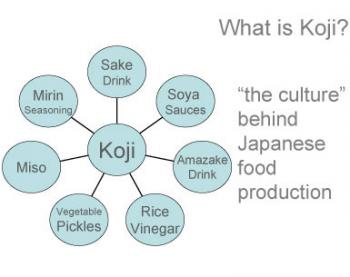Koji is the culture behind Japanese food production, discover what it is and how it is used.
What is Koji?
Koji is not actually a yeast, as many people mistakenly believe. Koji is cooked rice and/or soya beans that have been inoculated with a fermentation culture, Aspergillus oryzae. This naturally occurring culture is particularly prevalent in Japan, where it is known as koji-kin, which explains why so many Japanese foods have been developed over the centuries using it. It is used to make popular foods like soya sauce, miso, mirin and sake.
The first step in making these products is creating the koji. This involves adding the Aspergillus culture to steamed rice or soya beans or, in the case of shoyu soya sauce, to a combination of steamed soya beans and roasted, cracked wheat.
The resulting mixture is then placed in a warm and humid place for up to 50 hours, often in wooden trays called koji buta in Japanese. During this time the Aspergillus feeds on the rice or soya beans, using enzymes that are adept at breaking down carbohydrates and proteins.

How it is used?
Once it has been created, the koji is usually added to larger quantities of rice or soya beans, together with a brine solution. In the case of mirin, it is mixed with glutinous rice and the distilled alcoholic beverage shochu. In each case, the enzymes in the koji break down complex carbohydrates and proteins into amino acids, fatty acids and simple sugars.
When making sake, rice is mixed with koji, which breaks down the carbohydrates into sugars then subsequently fermented by yeast to produce alcohol and carbon dioxide.


The benefits of Koji
The amino acids, fatty acids and simple sugars released by the action of the koji add flavour, depth and, it has been argued, a number of health benefits to foods. For example, the fermentation of soya beans using koji to create miso is known to increase the levels of isoflavones (link to Q & A on isoflavones), which are compounds that are said to be effective in the prevention of cancer.
One of the amino acids released by the action of koji is glutamate, which imparts an intensely satisfying and delicious savoury taste known as umami. This, combined with the simple sugars also released, ensure that foods made using koji have a uniquely rounded and deep flavour.

Fluffy white grains of rice koji, here being used to make sake.

Making koji for Clearspring's mirin.

Clumps of rice are broken up to ensure that the koji develops in a uniform way.

The rice inoculated with kojikin culture is placed in wooden trays in a warm, humid atmosphere to propagate.

Miso is just one of the many traditional Japanese foods that relies on koji...

...as is sake, here served in a traditional wooden container called a masu.












